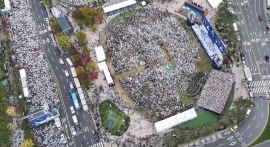On Wednesday the U.S. and Japan released an interim report on updates to defense cooperation guidelines between the two countries.
It has been 17 years since the guidelines to defense was last updated. The countries plan to finish the revisions by the end of this year.
According to the report, the new guidelines "will establish an expanded and more flexible framework for Alliance cooperation to ensure the peace and security of Japan under any circumstances, from peacetime to contingencies, and to promote a stable, peaceful, and prosperous Asia-Pacific and beyond."
The bilateral agreement establishes America's active defense of Japan. Some believe Japan desires security in light of conflicts with China over the ownership of the island known as Senkaku by Japan and Diaoyu by China. North Korea's nuclear weapon and missile development is another concern for the Japanese government.
Japan's updates to its defense cooperation with the U.S. highlights a new direction for both Japan as it takes a more active position in the international community and the U.S. as it seeks to become more involved in Eastern affairs.
"In addition to ensuring the ironclad defense of Japan, the revised guidelines will also better enable both countries to work with key partners outside of the region on important issues of shared interest such as humanitarian assistance and capacity building," states the report.
Back in July, Prime Minister Shinzo Abe announced a revision to a policy that allows the country to defend allies. This is a first for the country. Since World War II, Japan's military has been concerned only with protecting its own borders.
Prime Minister Abe stated, "Deterrence maintains peace" in regards to the shocking change. However, many believe that this deterrence may invite conflict since Japan's fortification of military may have the appearance of aggression.
Japan's neighbors South Korea and China are wary of the recent changes to Japan's policy with military and international involvement. Both countries suffered from Japan's occupation during World War II and are monitoring Japan's movement towards more active military.



















